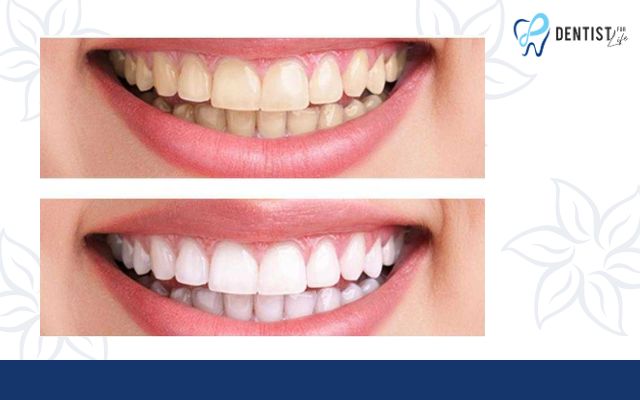Teeth whitening is a popular cosmetic dental procedure that can help improve the appearance of your smile. However, the cost of teeth whitening can vary depending on the type of treatment you choose and where you go for the procedure.
Bleaching vs. Whitening: What’s the Difference?
The FDA allows the term “bleaching” only for products that can whiten teeth beyond their natural color using bleach, such as hydrogen peroxide or carbamide peroxide. “Whitening,” on the other hand, refers to removing dirt and debris to restore a tooth’s surface color, making it applicable to products like toothpaste.
In-office whitening often uses fast-acting hydrogen peroxide, while at-home whitening typically involves slower-acting carbamide peroxide, which breaks down into hydrogen peroxide.

Types of teeth whitening
We won’t go into detail about the different options here because we have a separate teeth whitening guide that provides a more in-depth look at the ways to whiten your teeth. To understand teeth whitening costs, you need to know which procedures are available. All whitening treatments can be categorized into those involving a dentist and those that don’t. Let’s explore the costs of professional teeth whitening in the US.
Do teeth whitening cost professionals?
The most costly and quickest teeth whitening procedure is done in the dentist’s office. It involves applying a powerful bleaching gel, often with hydrogen peroxide, to your teeth and using a laser or LED light to speed up the bleaching process.
See more: What Does a Cavity Look Like?
An Examination of Tooth Enamel
The natural white color of teeth is due to their enamel surface, which is made up of microscopic crystalline rods and serves as a protective barrier against wear and tear from chewing, trauma, and acid attacks. However, as enamel wears down over time, it becomes more transparent, allowing the yellow color of dentin, the tooth’s core material, to become visible.
During normal chewing, enamel develops micro-cracks while dentin remains intact. These cracks, along with spaces between the enamel rods, gradually accumulate stains and debris, resulting in a dull appearance over time
Teeth whitening effectively removes these stains and debris, leaving the enamel cracks exposed. While some cracks are naturally re-mineralized by saliva, others may become filled with organic debris once again.
Tooth Discoloration: Extrinsic vs. Intrinsic Staining
Teeth staining falls into two categories: extrinsic and intrinsic.
Extrinsic stains appear on the tooth surface due to exposure to dark-colored substances, routine wear and tear, and tobacco. Superficial extrinsic stains can be removed with regular brushing and dental cleaning, while stubborn ones may require teeth whitening. If left untreated, persistent extrinsic stains can penetrate the dentin.
Intrinsic stains from inside the teeth due to various factors like trauma, aging, mineral exposure during tooth formation, or excessive fluoride ingestion. While previously considered resistant to bleaching, modern cosmetic dentistry suggests that even deep-set intrinsic stains can be addressed with supervised take-home teeth whitening over several months or a year. Alternatively, dental veneers can be used to treat intrinsic staining if other methods are ineffective.
What Causes Tooth Staining?
Age: Tooth color is directly related to age. As teeth undergo wear and tear and accumulate stains over the years, they tend to darken. Teenagers typically experience immediate, noticeable whitening results. In their twenties, teeth may begin to show a yellowish tint, requiring more effort for whitening. By the forties, the yellow shade may turn to brown, necessitating increased maintenance. In the fifties, stubborn stains may become deeply ingrained, proving challenging but not impossible to remove.
Starting color: Each person has an innate tooth color ranging from yellow-brown to greenish-gray, which intensifies with age. Yellow-brown teeth respond better to bleaching than green-gray ones.
Translucency and thinness: These genetic traits become more prominent with age. While all teeth exhibit some level of translucency, opaque and thick teeth appear lighter in color and respond well to bleaching. Thinner, more transparent teeth, especially front teeth, contain less pigment and are less responsive to bleaching. Cosmetic dentists note that transparency is a condition that cannot be corrected by any form of teeth whitening.
Eating habits: Regular consumption of deeply colored foods and beverages, such as red wine, coffee, tea, cola, carrots, and oranges, leads to significant staining over time. Acidic foods like citrus fruits and vinegar contribute to enamel erosion, making the teeth more transparent and allowing the yellow-colored dentin to show through.
Smoking habits: Nicotine leaves brownish deposits that gradually penetrate the tooth structure, causing intrinsic discoloration.
Drugs/chemicals: Tetracycline dosage during tooth formation leads to dark gray or brown ribbon stains that are challenging to remove. Excessive fluoride consumption causes fluorosis, characterized by faint white marks on the teeth and associated areas of white mottling.
Grinding: Stress-induced teeth grinding can lead to micro-cracking and darkening of the biting edges.
Trauma: Falls and injuries can result in substantial cracks in the teeth, which accumulate significant amounts of stains and debris.
What are Your Whitening Options?

There are three main teeth whitening options available today that use varying concentrations of peroxide and application times.
In-office whitening involves a high-concentration peroxide gel applied by a dentist or technician for an hour at most.
Professionally dispensed take-home kits use a lower-concentration peroxide gel applied with custom-made bleaching trays.
Over-the-counter products are the cheapest and most convenient but feature lower-concentration gels and may only whiten a few front teeth.
Costs range from $20 to $100 for over-the-counter products, $100 to $400 for take-home kits, and $650 per visit for in-office whitening.
Risks
Teeth whitening procedures are generally considered safe when performed according to guidelines. However, there are potential risks associated with bleaching that should be taken into account:
Sensitivity: Bleaching may cause a temporary increase in sensitivity to temperature, pressure, and touch. This is more likely to occur during in-office whitening, where higher concentrations of bleach are used. Some individuals may experience sudden shooting pains (“zingers”) down the middle of their front teeth. Those at higher risk for whitening sensitivity include individuals with gum recession, significant cracks in their teeth, or leakage from faulty restorations. It has been observed that redheads, even with no other risk factors, are particularly susceptible to tooth sensitivity and zingers. Whitening sensitivity typically lasts no longer than a day or two, but in some cases, it may persist for up to a month. Some dentists recommend using toothpaste containing potassium nitrate for sensitive teeth.
See more: Tooth extraction healing stages
Gum irritation: More than half of individuals using peroxide whiteners experience some level of gum irritation due to the concentration of bleach or contact with the trays. This irritation usually lasts for several days and dissipates after bleaching has ceased or the peroxide concentration has been reduced.
Technicolor teeth: Restorations such as bonding, dental crowns, or veneers are not affected by bleach and maintain their original color while the surrounding teeth are whitened. This can result in a phenomenon known as “technicolor teeth.”
Recommend teeth whitening cost near me
In conclusion, while the cost of teeth whitening may vary based on several factors such as the method chosen, the extent of treatment needed, and location, investing in professional teeth whitening at Dentist For Life ensures both effectiveness and safety.
Our experienced team provides tailored whitening solutions that deliver noticeable results, enhancing your smile’s brightness and overall appearance. Prioritizing your dental health and aesthetic goals, our clinic offers personalized consultations to discuss treatment options and associated costs.
Make an appointment with Dentist For Life to explore the best teeth whitening solutions that fit your needs and budget. Let our expertise and commitment to quality care help you achieve a radiant and confident smile affordably and effectively.



